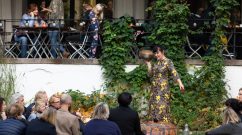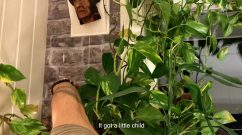Collaboration
Suppleness of Life in the Work of Torp & Liseth
by John Austin
It is fascinating to explore the artistic practice of Norwegian artists Torp & Liseth. It is equally compelling to situate their ink-on-paper drawings and acrylic on linen painting by referring to the dynamic space in the service of communication of ideas and emotions. In order to do this with some semblance of accuracy one must take into account a double set of reference points that inform these seemingly casual, yet highly disciplined, works.
This lack of surface control is purposefully and deliberately applied as a positive quality in their work. It is used to deftly relinquish one sort of linear, planar and spatial autonomy in order for the artists to assert an exquisite opening up of figural possibilities. The artists use their figural and figurative notations and marks derived from seemingly accidental procedures to stunning effects. This is autonomous mark making on the verge of disavowing its singularity, on the cusp of cleaving towards the representational. It is to become fully operational as a mimetic mirroring of something we know and recognize without being fully caught within an imagistic a-priori.
Accidental procedures in art making has a long and rich history. As historical background information it is useful to recall that Leonardo da Vinci, in his Treatise on Painting, speaks of process of interaction between making and matching in the projection of found images or accidentally-made patterns and the need for the artist to capitalize on these mental associa- tions. Torp & Liseth mark making fully exploits our innate ability to psychically project images and extract memories out of accidental accumulations. We can trace them in our experience and culture which build the core of our identity. This issue is both used and referred to in the Torp & Liseth installation which includes drawings, a video and a painting.
Stylistically, the artists use a deliniation technique and soft brushwork. In their linear works spare ink applications create another (perhaps deferred) measure of physiological impulses. What immediately commands our attention as viewers is the magisterial sense of scale within these small formats and playful cartoon-like narrative overtones.
In his discussion on the comic the French philosopher Henri Bergson makes the essential point that it is put into play when a level of incongruousness and a certain amount of inherent vitality is brought to our attention in unanticipated ways often by pitting opposites together, such as mechanistic artifice (and stringent inevitability of one kind) against natural and/or biologic (inescapability of fluid chance). He writes: “As we are both in and of it, we cannot help treating [society] as a living being. Any image …suggestive of the notion of a society disguising itself …will be laughable. Now such a notion is formed when we perceive anything inert or stereotyped, or simply readymade, on the surface of living society. There we have rigidity over again, clashing with the inner suppleness of life.” Henri Bergson, Laughter (Los Angeles: Green Integer) 45.
This passage expresses in some fair measure the quotient of vitality that courses through Torp & Liseth work that deals lightly yet effectively with feelings, perhaps, of loss, separation and loneliness. Within this balance of tensions the artists construct intimate scenes in which we perceive mindfulness (with its emphasis on non-closure) investigating the relation- ship between the individual and the universe. Energized and playful, these works hold us in suspense with the weight of their lightness and sensitivity.
Charging their surfaces with a play of energetic physical releases the artists compel us with their visual conundrums. Their works assert the picture plane with their own sense of inviolatedness. Each line and stroke is autonomous one minute, yet the next minute a magical transformation appears. Both drawings and the painting contain pure energy, undistilled sensa- tion, yet the force of these energetic fields yields another, casually superimposed correspondence to natural imagery. The result is poetic visual imagination at its best in which the activity of the work of art, in philosopher Etienne Gilson’s words, captures “a changing, fleeting, and always incomplete experience of a stable, complete and enduring entity.”
John Austin is a writer living and working in Manhattan.


